Scindapsus treubii ‘Dark Form’ is a cultivar of Scindapsus treubii characterized by lovely lance-shaped, glossy, dark green, or nearly black leaves. It is a rare, slow-growing climbing vine that requires low maintenance or care.
Sometimes, people call it Scindapsus treubii ‘Black’, ‘Dark’ or ‘Nearly Black’ due to its leaf color. We will use these names synonymously.
Besides the 'Dark Form', the other cultivars of S. treubii are Scindapsus treubii ‘Moonlight’, the rarer Scindapsus treubii ‘Mint’, and a few we will see later.
If you are new to this plant, you should know that the genus Scindapsus has mainly climbing vines native to Southeast Asia, New Guinea, a few western Pacific islands, and Queensland. You will find it in the rainforest jungles.
The other Scindapsus species are silver pothos or satin pothos (Scindapsus pictus) and the less known Scindapsus officinalis.
Finally, Scindapsus is a member of the arum family, Araceae, colloquially known as aroids. This family also has pothos, peace lilies, Monstera, Alocasia, ZZ plants, and philodendrons.
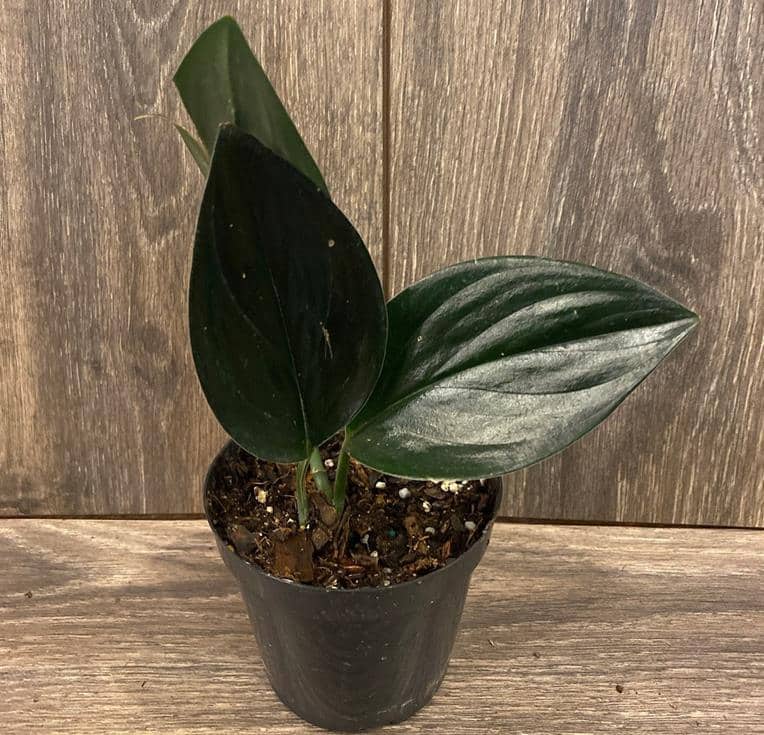
Contents
- Quick overview
- Where to grow Scindapsus treubii dark form
- Identification – appearance, and description
- 1. Size and growing habits
- 2. Leaves
- 3. Stems
- 4. Flowers
- Scindapsus treubii dark form care and growing needs
- 1. USDA Hardiness zone
- 2. Temperature
- 3. Humidity
- 4. Light
- 5. Best soil
- 6. Watering
- a). Overwatered Scindapsus treubii dark form
- b). Underwatered
- c). Which water to use?
- 7. Fertilizer
- 8. Pruning
- 9. Repotting
- Propagation
- a). What you need
- b). How to propagate Scindapsus treubii dark form
- Pests
- Diseases and conditions
- 1. Curling leaves
- 2. Yellowing of leaves
- Safety for pets and kids
- Other Scindapsus treubii varieties or cultivars
- 1. Scindapsus treubii Moonlight
- 2. Scindapsus treubii Mint
- 3. Scindapsus Dark Silver
- 4. Scindapsus treubii Sumatra
- 5. Scindapsus treubii Borneo
- FAQs
Quick overview
| Scientific name | Scindapsus treubii ‘Dark Form’ |
| Family | Araceae (arum family or aroids) |
| Common names | Scindapsus treubii black, Scindapsus treubii dark, Scindapsus nearly black |
| Native habitat | Southeast Asia, New Guinea, few western Pacific Islands, and Queensland |
| Type | Evergreen, perennial climbing vine |
| Size | 6 to 8 feet long and 1 to 3 feet wide |
| Leaves | Up to 20 inches long lance-shaped dark green to nearly black leaves |
| Stems | Greenish vines |
| Light requirement | Medium to bright indirect light but can tolerate lower light |
| USDA hardiness zone | 11B |
| Temperature | 60°F to 85°F with minimum temperature not going below freezing point |
| Humidity | Moderate to high humidity but can tolerate lower amounts. |
| Growth rate | Slow-growing |
| Soil | Slightly acid (6.0 to 6.6 pH), well-drained, high organic matter, potting mix |
| Watering | Moderate, letting top 2-3 inches of topsoil first dry |
| Propagation | Stem cutting |
| Toxicity | Toxic to humans, cats, dogs, rabbits, and other pets |
| Care level | Low |
Where to grow Scindapsus treubii dark form
You can have this lovely cultivar both indoors or outdoors. However, if you choose outdoors, ensure no direct sunlight, and winters don’t go below freezing point.
In your house, let your Scindapsus treubii dark form climb on a trellis, moss pole, or brass plant support. Some people love shingling it on a flat surface. It will look adorable.
Alternatively, you can grow them on a handing basket, letting them cascade downward, or on a pot and let them trail on a horizontal surface. A shelf, desktop, cabinet top, and so on will be ideal.
Finally, these plants can thrive in any room, so long as they are bright and humid and your pets or children cannot access them. We love the bathroom, but you can have them in your living or bedroom. Did you know that NASA lists them as one of the air purifying plants?
Identification – appearance, and description
If you are curious to know more about this nearly S. treubii black cultivar, we will look at its size, growing habits, leaves, stems, and flowers. We will also give you a few pictures.
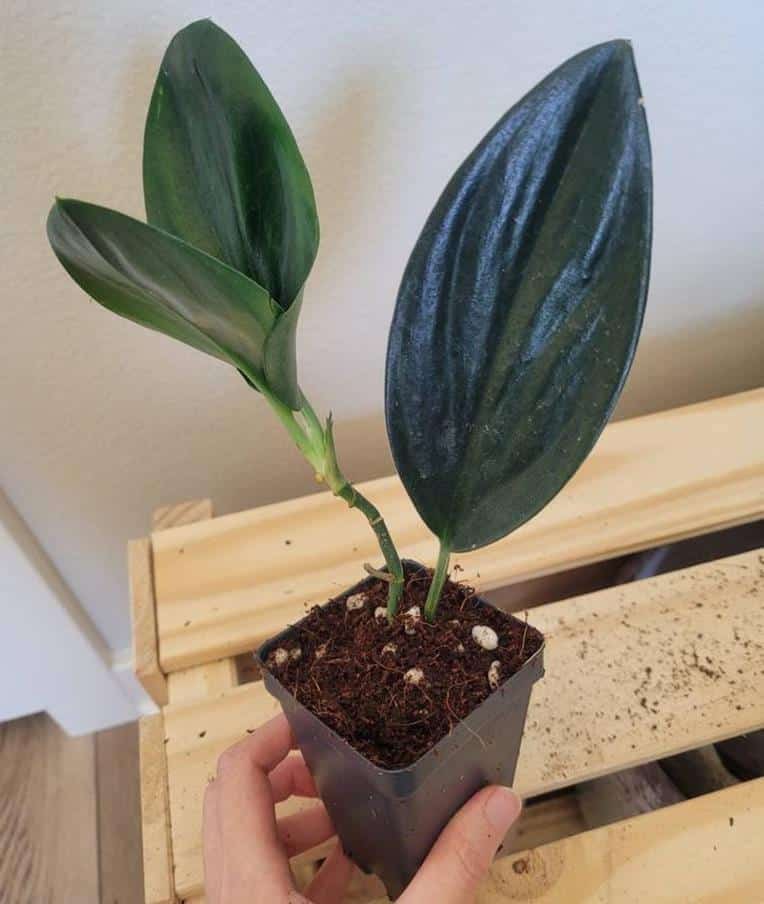
1. Size and growing habits
Scindapsus treubii Dark form is a slow-growing climbing vine. It has aerial roots to help it climb, besides performing other roles. When it doesn’t have vertical tree trunks or objects, it will trail on horizontal surfaces.
Usually, it grows as an understory plant in rainforest jungles while its natural habitat, where it receives filtered light or a partial shade
Finally, while in the wild, this plant can grow up to 6 to 8 feet long and 1 to 3 feet wide. However, at home, it may not grow as large. Also, it requires a place to climb and ideal growing conditions if you need it to grow to its full potential.
2. Leaves
The thick, glossy, lance-shaped dark green to almost black leaves are the main attraction of this plant and not flowers. However, the upper, younger leaves are light green but will darken as they mature.
Scindapsus treubii dark form has leaves ranging from 4 to 20 inches in length but will only grow to their full size if you let it climb.
Otherwise, the leaves may not reach their full size if you allow them to trail downwards (cascade) on a hanging basket or grow horizontally.
3. Stems
Scindapsus treubii nearly black stems are thin, smooth, and greenish. Leaves grow in an alternating pattern, and aerial roots grow on the opposite side of the leaves.
In the case of a new branch, it will sprout from the axil (angle between the stem and leaves).
4. Flowers
Yes, these are flowering plants. However, they will hardly flower under cultivation. Like most aroids, they bear their flowers on a spadix (an inflorescence flower born on a fleshly stalk).
Their flowers have only one ovule in each ovary and will bear round-shaped or bean-like seeds.
Scindapsus treubii dark form care and growing needs
Yes, this houseplant is rare, and you will not get a hold of it in most plant stores or nurseries. However, it isn’t a tough one when it comes to the care it needs.
Let us look at the care and growing needs.
1. USDA Hardiness zone
Like the other cultivars, Scindapsus treubii black USDA hardiness zone is 10B or above. This hardiness zone has a minimum average temperature of between +35 °F (1.7 °C) and +40 °F (4.4 °C).
People in this zone can grow these aroids outdoors all year. However, they need to avoid direct light and ensure they meet other growing conditions.
2. Temperature
Since these plants are native to the warm, humid tropical rainforest jungles (in Southeast Asia, Queensland, and New Guinea), they require warm conditions.
Therefore, the ideal Scindapsus treubii dark form temperature should range from 60 to 85 degrees Fahrenheit (15.6 to 29.4 °C). Your usual household temperatures are ok, and they wouldn’t mind a slightly higher or lower value.
However, ensure temperatures don’t reach freezing points. Also, avoid placing them on air conditioning vents or areas with drafts.
3. Humidity
S. treubii dark form prefers moderate to high relative humidity. Slightly high than what you have in most homes. Nonetheless, they can still grow well in places with lower humidity, including your household humidity range. 40 to 60% will be ok.
If you live in houses with lower humidity, your plant will love any attempt to raise it. Consider having a pebble tray, mist your plants regularly or invest in a humidifier. It should help you feel comfortable too.
For larger rooms buy LEVOIT 6 liter humidifier that runs for 60 hours. It has many cool features including a control app and works with Google assistant and Alexa voice asistant. If smaller, AquaOasis™ (amazon's best seller) will suffice.
4. Light
Scindapsus treubii dark form needs medium to bright indirect light. Nevertheless, they can still tolerate low lights but will grow slowly. Also, they may not have the best colorations.
Avoid placing this houseplant in direct sunlight as it will discolor or burn the leaves. Expect yellowish color and brownish, crispy edges and tips if placed under direct sunlight, especially when the sun is high in the sky.
If you grow your S. treubii dark form outdoors, go for places with filtered or partial shade. Also, you can have a greenhouse or a 40% shade cloth.
On the other hand, if you are in a dark place, consider buying grow lights an provide a 12 hours illumination. There are many good brands, GE Grow Light LED Flood Light Bulb is one of them. Couple it with a Dr. meter LX1330B Digital Illuminance Light Meter to be sure your plant gets 10k to 20k lux. This is the equivalent of bright, indirect light.
Finally, don’t worry if you have a west, east, south, or north-facing window. Just ensure no direct sunlight reaches your plant. Usually, you need to place your plant where direct sunlight doesn’t hit it. If space doesn’t allow it, use blinds.
5. Best soil
Ideal Scindapsus treubii dark form should be slightly acidic (pH 6.0 to 6.6), well-drained, and rich in organic matter.
However, aroids are not so picky when it comes to soil or growing media. They will thrive in almost anything you throw at them, so long as it is well-drained and nutrient-rich. We recommend you buy an aroid mix from Etsy.
I have seen people grow it in semi-hydroponics (LECA or clay aggregate), but we recommend an aroid potting mix.
Alternatively, go for the usual indoor potting mix but add about 10% perlite or pumice for better drainage.
Finally, there is nothing wrong with coming up with your mix, such as the one with potting soil, peat, bark, and perlite in ratios such as 3:2:4:1.
6. Watering
Many people have trouble when it comes to watering their houseplants. Most will overwater while a few may underwater.
If you have this aroid, you need to worry more about overwatering than underwatering. The thick leaves and waxy cuticles help retain moisture, meaning they can withstand some short drought.
Scindapsus treubii dark form requires moderate watering, i.e., they want moist soil but not too soggy or dry. Allowing them to sit in water will cause root rot.
Therefore, thoroughly water these plants until excess water comes out of the drainage holes. Discard any excess that collects in the saucer. Then, allow the first top 2 to 3 inches of soil or potting mix to dry before another round.
To you its watering time, feel the soil. It should be dry up to the 1st finger knuckle. Alternatively, buy XLUX Soil Moisture Meter and water when the reading is three or less. This meter is the most and best rated on Amazon. Also, it is accurate and responds fast. But there are other good ones too.
The other method is to wait until the leaves begin to curl upwards slightly before another watering session. We don't advocate for this method.
The other common issue that most people want to know is watering frequency. Usually, this depends on factors such as humidity, temperature, light, and season.
For instance, you need to water your plants more during spring or summer as they are actively growing. On the other hand, you should cut the amount in fall and winter (only ensure the soil doesn’t dry completely).
Also, you will water more when humidity is low, the temperature is high, or under bright light (grow fast). Low humidity or high temperatures increase moisture loss.
a). Overwatered Scindapsus treubii dark form
Overwatering is a problem for many houseplants. It happens if you frequently water them or your potting mix isn’t well-draining. Also, an oversized pot or one without drainage holes may be a factor.
The telltale signs that you have overwatered your plant include yellow leaves and a potting mix that is always wet or soggy. Other indicators are molds growing on potting mix surfaces and root rot signs.
b). Underwatered
While trying to avoid overwatering this aroid, it is possible to underwater it. Forgetting another watering session may be the other reason.
Signs of underwatered Scindapsus treubii nearly black include curling leaves, wilting and stunted growth. Others are a dry potting mix, and leaves may turn yellow or end up with crispy brown tips and edges.
c). Which water to use?
For misting and watering purposes, we recommend rain or distilled water. These two won’t leave mineral deposits in the soil that will necessitate soil flushing.
7. Fertilizer
Plant food will ensure lush and fuller growth. Therefore, fertilize the Scindapsus treubii black plant once after two weeks during spring and summer (growing season). Don’t fertilize during fall or winter.
Use fertilizers that are slightly higher in nitrogen to support foliage growth. Anything such as the 20:10:10 at half strength will be ok.
We have tried most of the top brands, and they all work well. Our favorite is Miracle-Gro Water Soluble All Purpose Plant Food, which is also Amazon's best seller. It has an NPK of 24-8-16. Also, it has other minerals like boron, copper, manganese, molybdenum, and zinc. Mix ¼ a teaspoon (half recommended strength) in a gallon of water and apply it.
If you want a slow-release formula, Osmocote Smart-Release for indoor and outdoor plants is our favorite. You will feed only once in four months. Apply ¾ of a tablespoon to an area of about a foot square and work it 1-3 inches into the soil.
8. Pruning
Besides removing damaged, old or dry leaves, this houseplant doesn’t require much pruning, i.e., they are slow-growers. However, if you want it bushier, prune off a few stems. It will encourage more branches.
When pruning, use a sterilized pruning knife or shear and only cut off a few branches at a time.
9. Repotting
Scindapsus treubii dark form doesn’t require frequent potting. They don’t grow fast and will take long to outgrow the current pot.
Therefore, repot these aroids after every couple of years or if they are root-bound. Roots growing from pot, wilting, stunted growth, yellowing of leaves, etc., may indicate they are root-bound.
Repot your plants in spring or summer and go for a pot that is 2-3 inches larger in diameter. Avoid oversized pots.
Propagation
Firstly, Scindapsus treubii dark form propagation is by stem cutting. You can opt for propagation in water or potting mix (soil). Since they grow slowly, we recommend potting mix as it facilitates quicker rooting. Also, transplanting won’t shock your plants.
Secondly, always propagate your plants in early spring to give them time to root well. Summer is ok. However, avoid winter or fall.
a). What you need
- Sterilized pruning knife or shear
- A small pot
- Potting mix
- Rooting hormone (optional). But consider having it if you want to increase your success rate and reduce rooting duration. We love the gel formuation of HydroDynamics Clonex by Growth Technology (UK). It will provide hormones to spur rooth growth and some nutrients.
- Transparent plastic bag (optional)
b). How to propagate Scindapsus treubii dark form
- Using your pruning knife or shear, cut a stem with a few leaves just below a node. One with an aerial root will promote faster rooting. Remove any lower leaves, leaving the upper one or two.
- Apply your rooting hormone. This step is not a must but a rooting hormone will make your plant to root faster and reduce the chances of decay.
- Put your potting mix inside your pot, make a small hole using a stick, finger, or pencil and plant your stem cutting. Ensure the soil firmly holds the cutting and the node is inside the potting mix.
- Water your cutting until excess water comes out of the drainage holes.
- Cover it with a transparent plastic bag, ensuring the cutting leaves don’t touch the bag’s surface. Also, leave a small opening, i.e., don’t seal it completely to allow for air circulation.
- Place the cutting in a warm place with bright, indirect light. For faster propagation, maintain 70 to 75 degrees Fahrenheit (21-24 °C) temperature.
- Routinely, remove the plastic bag to allow your cutting to breathe fresh air. Also, check to ensure the soil remains moist and not so wet. If dry, lightly water it.
Your plant will start rooting after 2 to 4 weeks. However, it may take up to a month or two before it is ready for transplanting.
Finally, if you opt for propagation in water, change the water when it becomes cloudy. Also, covering the jar will help reduce algae growth.
Pests
So far, we have not had any experience with pests. The plant seems to hold on very well. However, if grown outdoors, scale and spider mites may attack your plant. However, this rarely happens.
Diseases and conditions
We haven’t had any episodes of fungal, bacterial, or viral diseases. These plants seem not so susceptible.
Nonetheless, always use sterilized pruning scissors or shears. Also, ensure you clean your hands if you have been handling other plants to avoid transmitting disease.
Besides overwatering and underwatering, some conditions that may occur to this plant include the following:
1. Curling leaves
The first suspect curling leaves in Scindapsus treubii dark form is underwatering. Usually, it makes the leaves curl upwards.
Besides underwatering, other reasons may be pests, diseases, heat stress, lack of nutrients, or overwatering (which occurs when root rot is present)
2. Yellowing of leaves
Yellow leaves in Scindapsus treubii dark form are caused by overwatering. Kindly check for any signs that you have overwatered these plants.
Additionally, the yellowing may be due to poor lighting, direct sunlight, underwatering, extreme temperatures, and low humidity. Also, normal aging, pets, and diseases may be a cause.
Safety for pets and kids
Scindapsus treubii dark form is toxic or poisonous to humans, dogs, cats, rabbits, bearded dragons, iguanas, and other pets.
All parts of the plant (roots, leaves, or vines) are toxic. Therefore, don’t offer it to your pets or allow your kids to access it
The reason for toxicity is microscopic, needle-like insoluble calcium oxalates. When chewed or ingested, they will cause the following symptoms:
- Oral pain and extreme irritation
- Mouth pawing and drooling
- Swallowing difficulties
- Swollen and redness of lips, tongue, or mouth
Other Scindapsus treubii varieties or cultivars
Besides the dark form, other S. treubii varieties cultivars include the following:
1. Scindapsus treubii Moonlight
Scindapsus treubii Moonlight is a trending, adorable houseplant with oval or heart-shaped green leaves with a silvery overlay and a green streak along the mid-rib.
This evergreen, climbing flowering vine is also a slow-grower with care needs more or less what we have looked at above. Below is a picture.
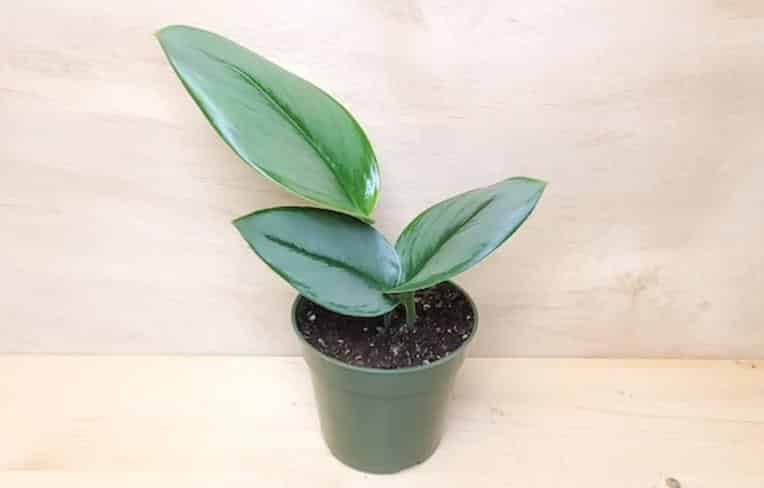
2. Scindapsus treubii Mint
S. treubii mint is an extremely rare and expensive variegated form cultivar. It has heart-shaped green leaves with mint variegations.
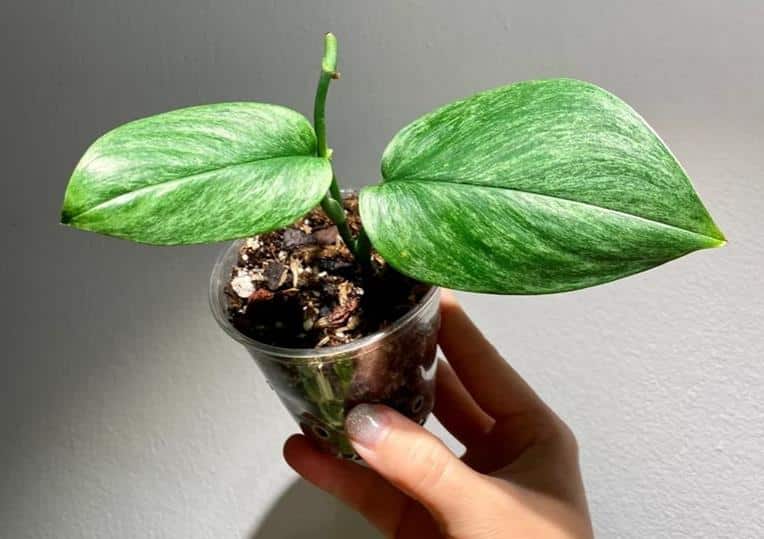
3. Scindapsus Dark Silver
We are not sure about the name. Some people call it Scindapsus treubii Dark form variegated, and others Scindapsus dark silver. This charming but scarce plant has dark to nearly black oval leaves with silvery markings or streaks.
Plantbuys.com and ardsale.com have it. However, there isn’t much detail about this rare houseplant.
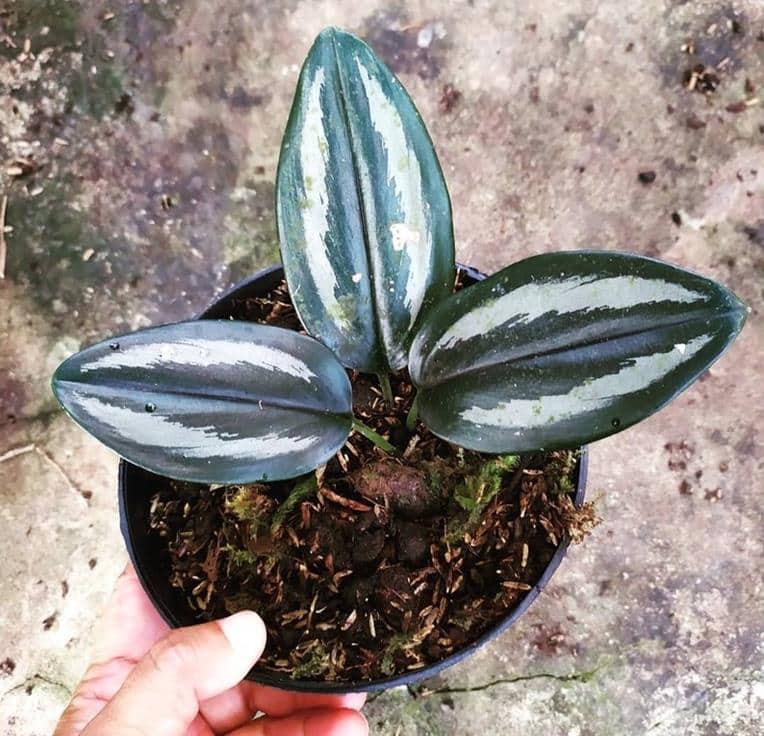
4. Scindapsus treubii Sumatra
S. treubii Sp Sumatra is another cultivar with dark green or nearly black leaves with silvery splotches on the upper surface.
It somewhat resembles S. treubii moonlight except for the darker leaves and the striations. It is available at Plantcericle.co.
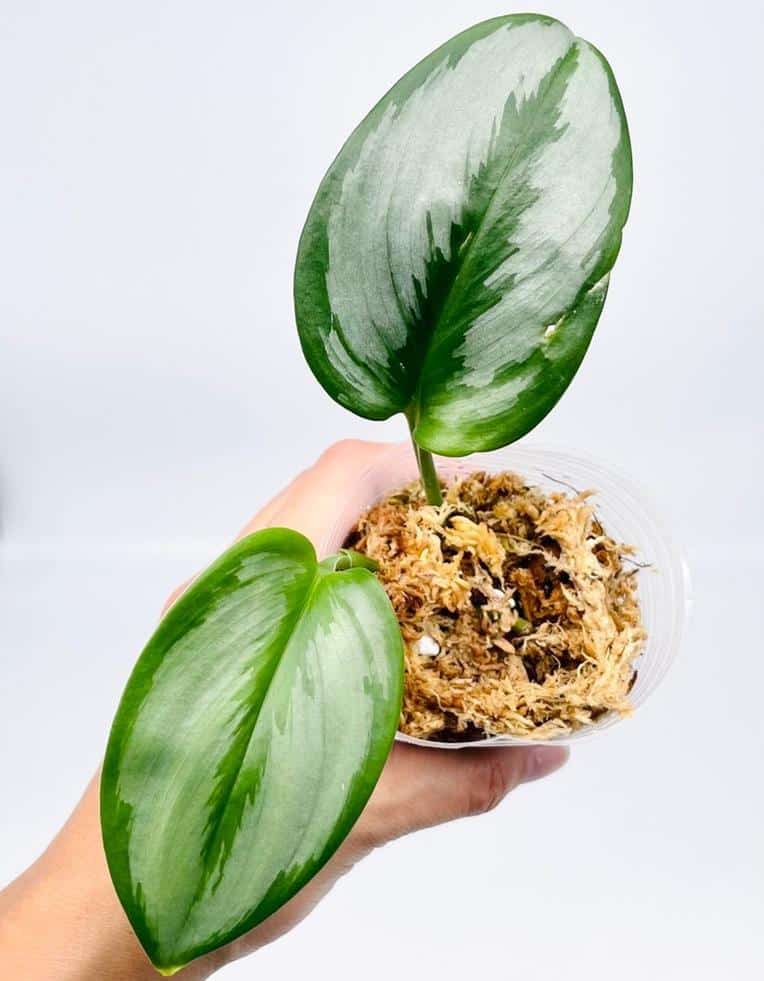
5. Scindapsus treubii Borneo
S. treubii Borneo closely resembles the Sumatra cultivar, with a slight difference in how the silver markings appear.

FAQs
Yes. Scindapsus treubii dark form is a very rare houseplant, especially in the US and Canada. Most houseplant stores and nurseries don’t sell it. However, it is not so rare in the UK and other parts of Europe, but not readily available either.
The best place to buy S. treubii Dark Form is Etsy.com. Coast Farms, Walmart, or Home Depot don’t have it.
Besides Etsy.com, you can also try looking for it in Facebook houseplant groups, Plantcircle.co, Craftedidentity.com, Aroidmarket.com, Aroidsale.com, and other small-scale specialty growers.
The average price of Scindapsus treubii dark form ranges from $20 to $70. However, some vendors sell it higher while you can still get it for as low as $10.


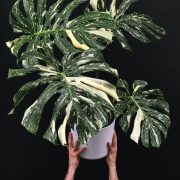
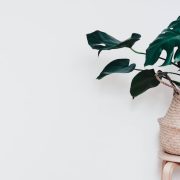
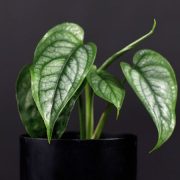
Leave a Reply